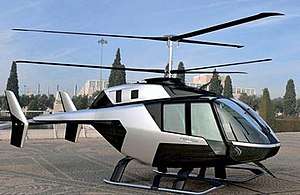VRT 500
| VRT-500 | |
|---|---|
 | |
| Role | Light Helicopter |
| Manufacturer | Russian Helicopters |
| First flight | 2019[1] |
| Introduction | 2020-21[2] |
The VRT 500 is a light helicopter project by Russian Helicopters and developed by its subsidiary VR-Technologies.
Development
First announced in March 2007, a mock-up was presented at the 2017 MAKS airshow, Russian type certification might come in 2017 and series production is planned for 2020-21.[2] Rotor system strength were tested in 2018 before aerodynamic tests, while a prototype will be produced by the end of 2019. It targets 15% of the sub 2 tons global civil market, 700 helicopters by 2030,[3] First flight is scheduled for 2019 as 1,000 units could be sold by 2035.[1]
Design
The single-engine aircraft has twin three-blade coaxial rotors.[2] The most likely western powerplant is the Safran Arrius.[4] It features shaped carbon fiber main blades to cut noise emissions, composite construction, a glass cockpit and sliding rear cabin doors, and will compete with the Bell 505 and Robinson R66.[5] Multiple configurations will be provided: passenger, utility, cargo, training, VIP, and Medevac with rear cabin doors loading.[3]
Specifications
Source: Aviation International News[5]
See also
Similar configuration
- Kamov Ka-26, coaxial, three blade with twin piston engines with an interchangeable mission cabin
- Kamov Ka-126, single engine development
- Kamov Ka-226 twin engine development
Competition
References
- 1 2 3 4 Michael Gubisch (24 May 2018). "Russian Helicopters unveils VRT500". Flightglobal.
- 1 2 3 Valentin Makov (July 18, 2017). "MAKS: Russian company presents VRT500 light helicopter mockup". Russian Aviation Insider.
- 1 2 "Rostec to create VRT500 prototype by the end of 2019" (Press release). Russian Helicopters. 19 Apr 2018.
- ↑ Alex Mladenov (25 July 2017). "Russian Helicopters move into single-engine market". Shepard Media.
- 1 2 Mark Huber (August 8, 2017). "Russia Unveils Coaxial Single". Aviation International News.